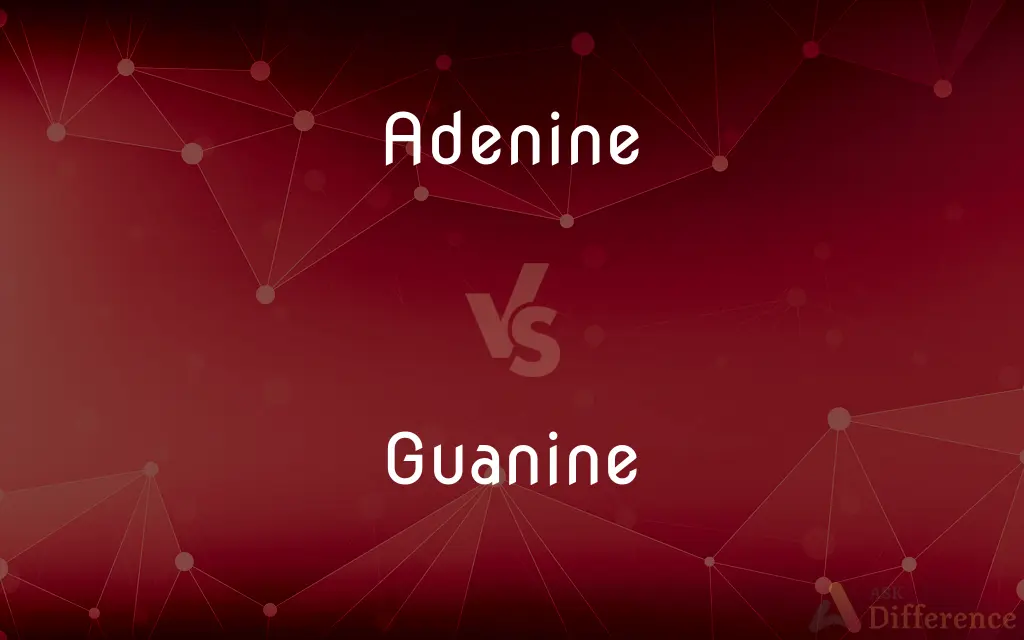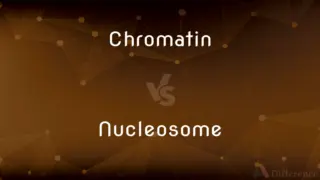Adenine vs. Guanine — What's the Difference?
By Tayyaba Rehman & Urooj Arif — Updated on April 26, 2024
"Adenine and guanine are both nitrogenous bases crucial to DNA and RNA structure; adenine pairs with thymine or uracil, while guanine pairs with cytosine."

Difference Between Adenine and Guanine
Table of Contents
ADVERTISEMENT
Key Differences
Adenine and guanine are purine bases found in both DNA and RNA, which means they share a double-ring structure that is integral to their function. However, adenine pairs with thymine in DNA and with uracil in RNA, whereas guanine consistently pairs with cytosine across both types of nucleic acids.
In the Watson-Crick base pairing model, adenine forms hydrogen bonds with thymine or uracil—two in RNA and two in DNA—ensuring proper genetic encoding and transcription. In contrast, guanine forms three hydrogen bonds with cytosine, which contributes to the stability of the DNA double helix.
Adenine plays a crucial role in energy transfer within cells, particularly through molecules like ATP (adenosine triphosphate), whereas guanine is less involved in such processes. Guanine, however, contributes to the GTP (guanosine triphosphate) molecule, which is important for protein synthesis and signal transduction.
Structurally, adenine has an amine group at its 6-position, whereas guanine has a carbonyl group at the 6-position and an additional amine group at the 2-position, distinguishing their chemical properties and interactions within nucleic acids.
The ability of adenine and guanine to participate in forming nucleotides—the building blocks of DNA and RNA—underscores their essential roles in genetic information storage and transfer, while their chemical differences influence the physical and functional properties of nucleic acids.
ADVERTISEMENT
Comparison Chart
Nitrogenous Base Type
Purine
Purine
Pairs With
Thymine (DNA), Uracil (RNA)
Cytosine (both DNA and RNA)
Hydrogen Bonds Formed
2
3
Role in Energy Molecules
Integral in ATP
Integral in GTP
Structural Features
Amine group at the 6-position
Carbonyl and amine groups at the 6 and 2 positions respectively
Compare with Definitions
Adenine
Involved in genetic coding and transcription processes.
Adenine's pairing with uracil is crucial during RNA transcription.
Guanine
A purine nucleobase that pairs with cytosine in both DNA and RNA.
Guanine and cytosine pair through three hydrogen bonds, providing stability to the DNA structure.
Adenine
Found in both DNA and RNA strands.
Adenine is crucial for the structure and function of both types of nucleic acids.
Guanine
Plays a key role in the genetic encoding within cells.
The specific pairing between guanine and cytosine is crucial for maintaining the genetic code across generations.
Adenine
Structurally distinct for lacking an oxygen atom at the 6-position unlike guanine.
The lack of an oxygen atom at the 6-position in adenine affects its pairing properties.
Guanine
Essential for the proper structure of DNA and RNA.
Guanine’s structural role in nucleic acids is fundamental to genetic integrity.
Adenine
A purine nucleobase in DNA and RNA that pairs with thymine or uracil.
Adenine forms two hydrogen bonds with thymine in DNA.
Guanine
Has a carbonyl group at the 6-position, making it chemically distinct from adenine.
The carbonyl group at the 6-position of guanine contributes to its unique hydrogen bonding properties.
Adenine
Component of ATP, essential for energy transfer.
Cellular processes are fueled by the energy released from ATP, where adenine is a key component.
Guanine
Component of GTP, used in protein synthesis and signal transduction.
GTP, which includes guanine, is vital for transmitting signals within cells.
Adenine
Adenine (A, Ade) is a nucleobase (a purine derivative). It is one of the four nucleobases in the nucleic acid of DNA that are represented by the letters G–C–A–T. The three others are guanine, cytosine and thymine.
Guanine
Guanine (; or G, Gua) is one of the four main nucleobases found in the nucleic acids DNA and RNA, the others being adenine, cytosine, and thymine (uracil in RNA). In DNA, guanine is paired with cytosine.
Adenine
A purine base, C5H5N5, that is the constituent involved in base pairing with thymine in DNA and with uracil in RNA.
Guanine
A purine base, C5H5ON5, that is an essential constituent of both RNA and DNA.
Adenine
A base, C5H5N5, found in certain glands and tissues, which pairs with thymine in DNA and uracil in RNA.
Guanine
(chemistry) A substance first obtained from guano; it is a nucleic base and pairs with cytosine in DNA and RNA (by means of three hydrogen bonds).
Adenine
(biochemistry) purine base found in DNA and RNA; pairs with thymine in DNA and with uracil in RNA
Guanine
A purine base found in DNA and RNA; pairs with cytosine
Common Curiosities
Why is the number of hydrogen bonds important for adenine and guanine?
The number of hydrogen bonds influences the stability of the DNA double helix. Adenine forms two bonds, making it less thermally stable compared to guanine, which forms three bonds.
How do mutations affect adenine and guanine pairing?
Mutations can lead to mispairing, where adenine might incorrectly pair with cytosine, or guanine with thymine, potentially leading to genetic disorders.
Are adenine and guanine involved in any cellular signaling pathways?
Guanine is involved in signaling pathways through its role in GTP, which is essential for protein synthesis and signal transduction processes.
What role does adenine play in energy metabolism?
Adenine forms part of ATP, the primary energy currency of the cell, playing a critical role in energy transfer for metabolic processes.
What is the basic structure of adenine and guanine?
Both adenine and guanine are purine bases, which means they have a two-ring structure that includes fused pyrimidine and imidazole rings.
How do adenine and guanine contribute to genetic diseases?
Incorrect incorporation or mutation involving these bases can lead to mismatches in the DNA sequence, contributing to diseases like cancer.
Can adenine and guanine be found in other biological molecules besides DNA and RNA?
Yes, adenine is part of adenosine triphosphate (ATP) and nicotinamide adenine dinucleotide (NAD), and guanine is part of guanosine triphosphate (GTP) and cyclic GMP.
How are adenine and guanine synthesized in the body?
Both bases are synthesized through the purine synthesis pathway, which involves several enzyme-catalyzed reactions starting from amino acids and other molecules.
What is the significance of guanine's additional oxygen atom?
The oxygen atom at the 6-position in guanine is crucial for forming an extra hydrogen bond with cytosine, which enhances the stability of the DNA molecule.
What happens to adenine and guanine during DNA replication?
During DNA replication, adenine and guanine are copied so that each new strand of DNA contains the appropriate base pair, ensuring genetic continuity.
What dietary sources provide adenine and guanine?
Adenine and guanine are obtained through dietary intake of nucleic acids from foods like meats, fungi, and legumes, which are then broken down by the body.
How do adenine and guanine interact with other bases during transcription?
During transcription, adenine in DNA pairs with uracil in RNA, and guanine continues to pair with cytosine, facilitating the accurate transcription of genetic information into RNA.
What is the impact of environmental factors on adenine and guanine?
UV light and chemicals can induce mutations in these bases, leading to DNA damage that might result in cancer if not repaired properly.
What are the implications of adenine and guanine research in biotechnology?
Research into these bases has implications for genetic engineering, drug design, and understanding the molecular basis of diseases, enhancing the development of targeted therapies and diagnostic tools.
Can adenine or guanine levels affect health?
Yes, abnormalities in purine metabolism can lead to health issues such as gout, which is influenced by the breakdown products of adenine and guanine.
Share Your Discovery

Previous Comparison
Chromatin vs. Nucleosome
Next Comparison
Longhorn vs. OxenAuthor Spotlight
Written by
Tayyaba RehmanTayyaba Rehman is a distinguished writer, currently serving as a primary contributor to askdifference.com. As a researcher in semantics and etymology, Tayyaba's passion for the complexity of languages and their distinctions has found a perfect home on the platform. Tayyaba delves into the intricacies of language, distinguishing between commonly confused words and phrases, thereby providing clarity for readers worldwide.
Co-written by
Urooj ArifUrooj is a skilled content writer at Ask Difference, known for her exceptional ability to simplify complex topics into engaging and informative content. With a passion for research and a flair for clear, concise writing, she consistently delivers articles that resonate with our diverse audience.
















































